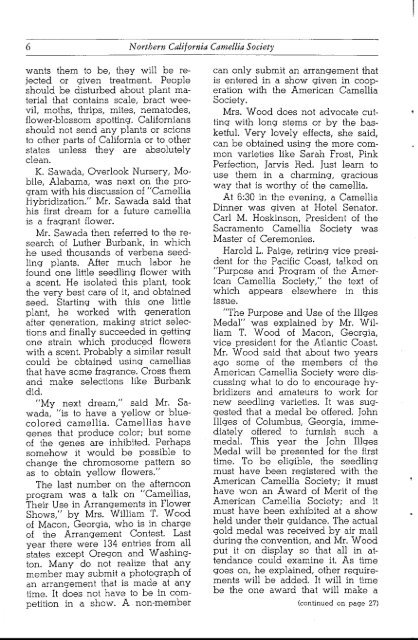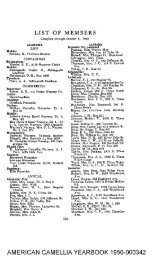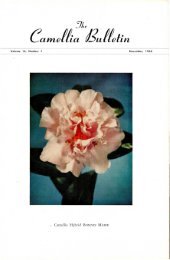CAMELLIA JAPONICA - GOVERNOR EARL WARREN - Immense ...
CAMELLIA JAPONICA - GOVERNOR EARL WARREN - Immense ...
CAMELLIA JAPONICA - GOVERNOR EARL WARREN - Immense ...
You also want an ePaper? Increase the reach of your titles
YUMPU automatically turns print PDFs into web optimized ePapers that Google loves.
6 Northern California Camellia Society<br />
wants them to be, they will be rejected<br />
or given treatment. People<br />
should be disturbed about plant material<br />
that contains scale, bract weevil,<br />
moths, thrips, mites, nematodes,<br />
flower-blossom spotting. Californians<br />
should not send any plants or scions<br />
to other parts of California or to other<br />
states unless they are absolutely<br />
clean.<br />
K. Sawada, Overlook Nursery, Mobile,<br />
Alabama, was next on the program<br />
with his discussion of "Camellia<br />
Hybridization." Mr. Sawada said that<br />
his first dream for a future camellia<br />
is a fragrant flower.<br />
Mr. Sawada then referred to the research<br />
of Luther Burbank, in which<br />
he used thousands of verbena seedling<br />
plants. After much labor he<br />
found one little seedling flower with<br />
a scent. He isolated this plant, took<br />
the very best care of it, and obtained<br />
seed. Starting with this one little<br />
plant, he worked with generation<br />
after generation, making strict selections<br />
and finally succeeded in getting<br />
one strain which produced flowers<br />
with a scent. Probably a similar result<br />
could be obtained using camellias<br />
that have some fragrance. Cross them<br />
and make selections like Burbank<br />
did.<br />
"My next dream," said Mr. Sawada,<br />
"is to have a yellow or bluecolored<br />
camellia. Camellias have<br />
genes that produce color; but some<br />
of the genes are inhibited. Perhaps<br />
somehow it would be possible to<br />
change the chromosome pattern so<br />
as to obtain yellow flowers."<br />
The last number on the afternoon<br />
program was a talk on "Camellias,<br />
Their Use in Arrangements in Flower<br />
Shows," by Mrs. William T. Wood<br />
of Macon, Georgia, who is in charge<br />
of the Arrangement Contest. Last<br />
year there were 134 entries from all<br />
states except Oregon and Washington.<br />
Many do not realize that any<br />
member may submit a photograph of<br />
an arrangement that is made at any<br />
time. It does not have to be in competition<br />
in a show. A non-member<br />
can only submit an arrangement that<br />
is entered in a show given in cooperation<br />
with the American Camellia<br />
Society.<br />
Mrs. Wood does not advocate cutting<br />
with long stems or by the basketful.<br />
Very lovely effects, she said,<br />
can be obtained using the more common<br />
varieties like Sarah Frost, Pink<br />
Perfection, Jarvis Red. Just learn to<br />
use them in a charming, gracious<br />
way that is worthy of the camellia.<br />
At 6:30 in the evening, a Camellia<br />
Dinner was given at Hotel Senator.<br />
Carl M. Hoskinson, President of the<br />
Sacramento Camellia Society was<br />
Master of Ceremonies.<br />
Harold L. Paige, retiring vice president<br />
for the Pacific Coast, talked on<br />
"Purpose and Program of the American<br />
Camellia Society," the text of<br />
which appears elsewhere in this<br />
issue.<br />
"The Purpose and Use of the Illges<br />
Medal" was explained by Mr. William<br />
T. Wood of Macon, Georgia,<br />
vice president for the Atlantic Coast.<br />
Mr. Wood said that about two years<br />
ago some of the members of the<br />
American Camellia Society were discussing<br />
what to do to encourage hybridizers<br />
and amateurs to work for<br />
new seedling varieties. It was suggested<br />
that a medal be offered. John<br />
Illges of Columbus, Georgia, immediately<br />
offered to furnish such a<br />
medal. This year the John Illges<br />
Medal will be presented for the first<br />
time. To be eligible, the seedling<br />
must have been registered with the<br />
American Camellia Society; it must<br />
have won an Award of Merit of the<br />
American Camellia Society; and it<br />
must have been exhibited at a show<br />
held under their guidance. The actual<br />
gold medal was received by air mail<br />
during the convention, and Mr. Wood<br />
put it on display so that all in attendance<br />
could examine it. As time<br />
goes on, he explained, other requirements<br />
will be added. It will in time<br />
be the one award that will make a<br />
(continued on page 27)




